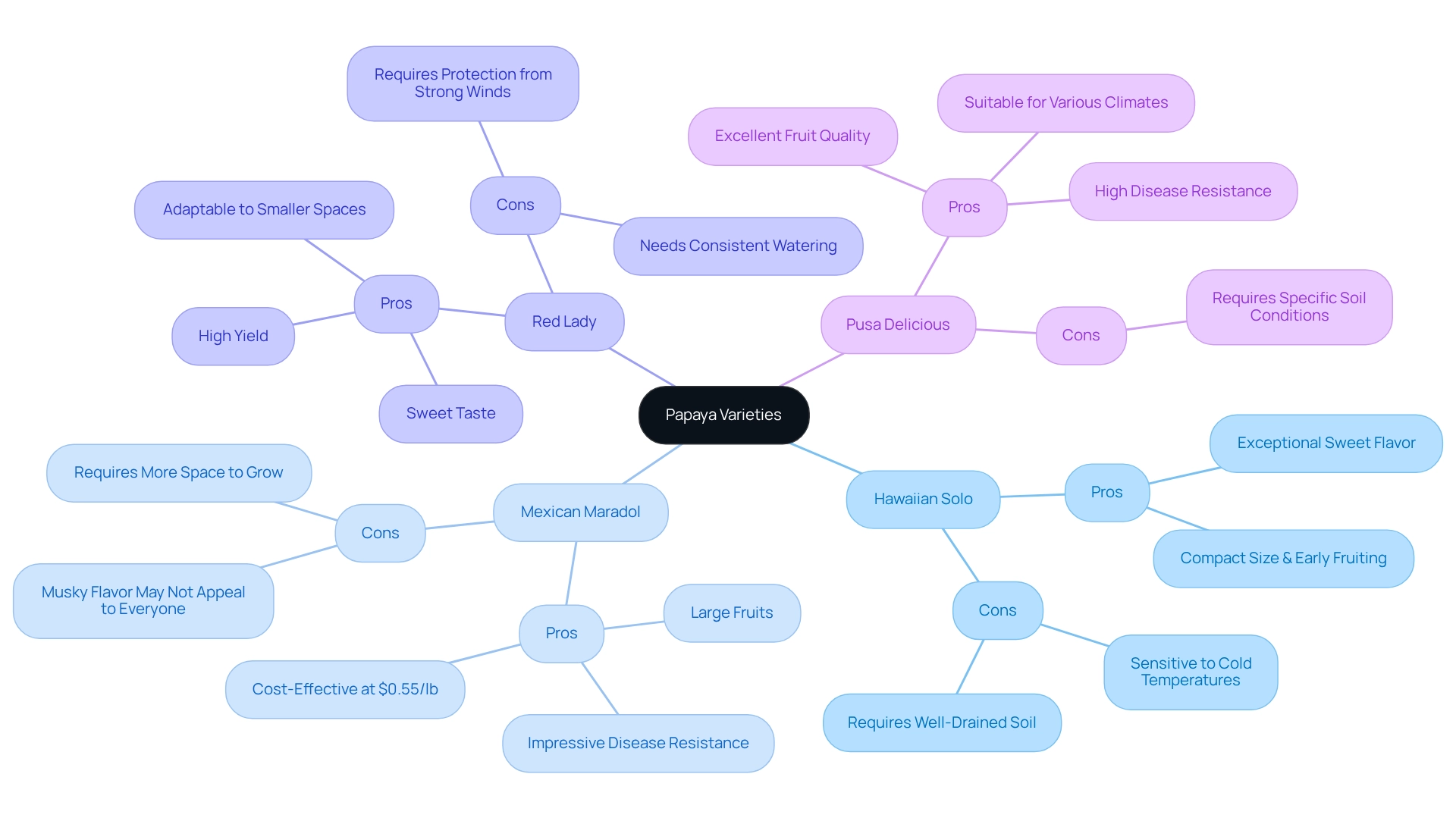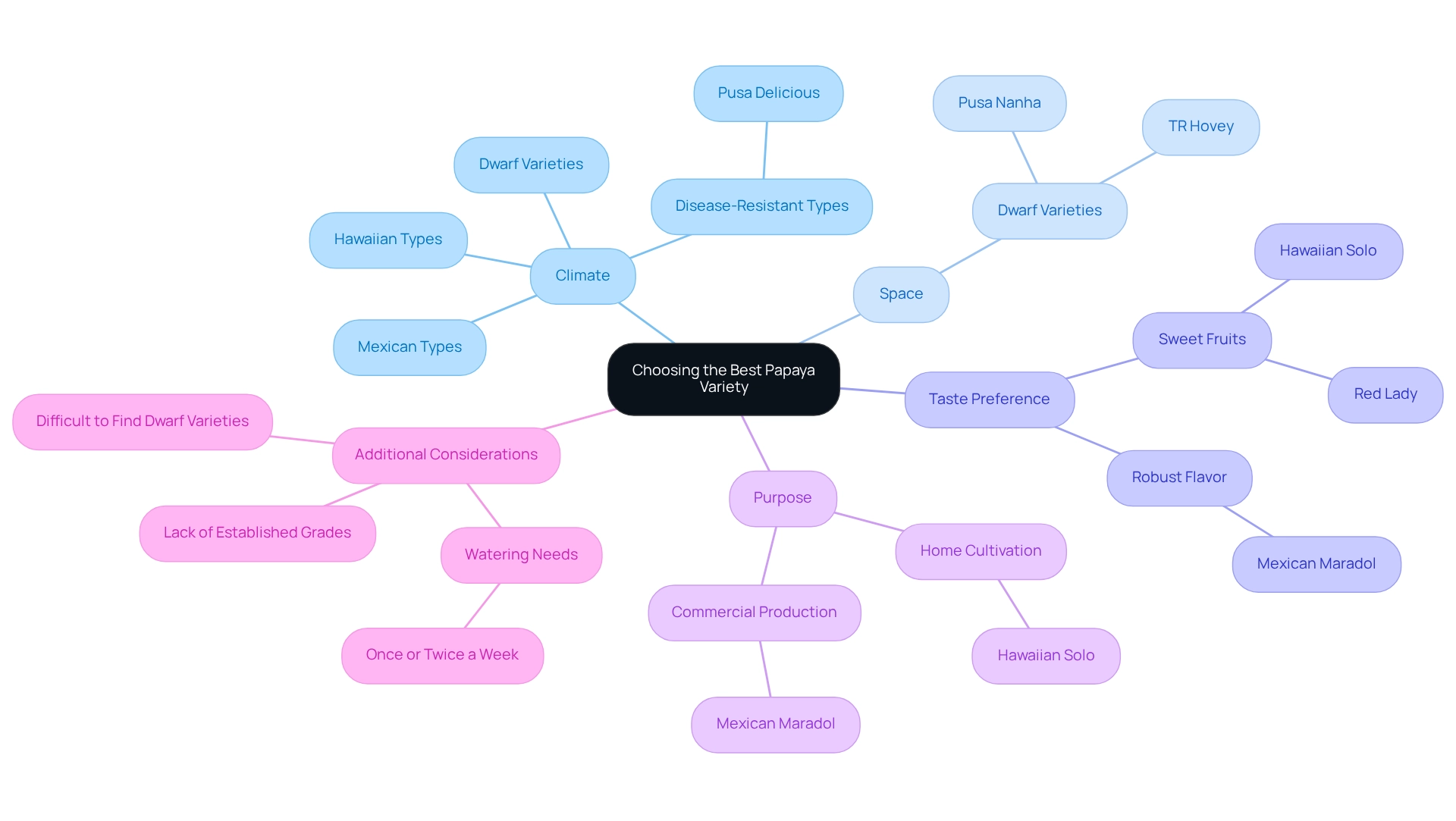
Best Variety of Papaya: Compare Characteristics and Suitability
Share
Looking for the perfect papaya tree to grow at home? Whether you're after tropical flavor, compact size, or high yield, there's a variety for every garden. In this guide, we’ll compare top papaya types—Hawaiian, Mexican, Indian—and help you choose what’s best for your climate, space, and taste.
👉 Shop All Papaya Trees at Everglades Farm
Need help growing your papaya ttree? Check out:
🥭 Explore the popular Maradol Red Dwarf, Red Lady, Hawaiian, and Solo Papaya varieties, ready to grow in your own backyard.
Choosing the best variety of papaya can feel overwhelming, but it’s all about understanding your unique gardening situation. Factors like climate, available space, taste preferences, and intended use play crucial roles in this decision. Many gardeners find Hawaiian varieties particularly appealing due to their delightful sweetness and compact growth, making them a favorite choice.
In this article, we’ll explore the characteristics and suitability of Hawaiian, Mexican, and Indian papayas. By acknowledging the challenges you may face, we aim to provide you with solutions that resonate with your gardening journey. Understanding these factors will empower you to make informed choices that align with your specific needs and conditions.
Remember, gardening is a personal experience, and we’re here to support you every step of the way. As you consider which papaya variety to plant, think about what will bring you joy and satisfaction in your garden. Let’s embark on this journey together, nurturing our green spaces with love and care.
Introduction
In the vibrant world of gardening, few fruits capture our imagination quite like the papaya. With its tropical allure and diverse varieties—from the sweet Hawaiian Solo to the robust Mexican Maradol—papayas present a wealth of options for both home gardeners and commercial growers. Each type brings its own unique characteristics, flavors, and cultivation requirements, making the choice of which variety to grow a pivotal decision.
Have you ever felt overwhelmed by the choices available? This article delves into the fascinating characteristics and classifications of papayas, evaluates the pros and cons of popular varieties, and provides essential guidance for selecting the perfect papaya to suit your gardening needs. Whether you’re aiming for a bountiful harvest or simply enhancing your garden's aesthetic, understanding these tropical gems is crucial for a successful gardening journey. Together, let’s explore the beauty and joy that growing papayas can bring to your life.
Explore Papaya Varieties: Characteristics and Classifications
Papayas can be classified into three main varieties: Hawaiian, Mexican, and Indian, with the Hawaiian varieties often considered the best variety of papaya, each offering unique traits that cater to different gardening requirements and personal tastes. They are cherished for their sweet, vibrant orange flesh and minimal seed content, which makes them a favorite among home gardeners. With their compact growth habit, they thrive even in limited spaces, yielding approximately 20-30 tonnes per hectare under optimal conditions.
Mexican Papayas
Larger in size, these fruits can weigh up to 10 pounds and are known for their musky flavor. Mexican varieties are particularly favored in commercial production due to their size and resilience, thriving in various climates. They can also provide substantial yields, often exceeding 15 tonnes per hectare, making them an excellent choice for those looking to maximize their garden's output.
Indian Papayas
Varieties like 'Pusa Delicious' and 'Red Lady' are celebrated for their unique flavors and textures. Adaptable to diverse climates, Indian fruits are appreciated for their sweetness. While they require specific growing conditions, the best variety of papaya can flourish in home gardens with the right attention, adding a charming touch to any tropical produce assortment. When choosing the best variety of papaya, it's essential to consider local climate factors, available space, and your individual taste preferences. Each variety presents unique growing requirements and flavor profiles, making informed choices crucial for successful cultivation.

Evaluate the Pros and Cons of Popular Papaya Varieties
Let’s take a closer look at some beloved papaya varieties that might just be the perfect fit for your garden:
-
- Pros: This delightful variety is celebrated for its exceptionally sweet flavor. The Hawaiian Solo is compact and fruits early, making it a wonderful choice for home gardeners eager for quick yields. While Solo-type fruits tend to command premium prices in the US market due to limited supplies and higher shipping costs, they are cherished by those who prioritize taste.
- Cons: On the flip side, it is sensitive to cold temperatures and flourishes only in well-drained soil, which might limit its cultivation in cooler climates.
-
- Pros: If you’re looking for size, this variety boasts large fruits and is well-suited for commercial production, thanks to its impressive disease resistance. Its robust nature makes it a reliable choice for gardeners aiming for substantial yields. With average prices around $0.55/lb, Maradol-type papayas can be a cost-effective option for many.
- Cons: However, the musky flavor of Maradol may not be to everyone's liking, and it does require more space to grow effectively, which could be a consideration for those with limited garden areas.
-
- Pros: The Red Lady variety is loved for its high yield and sweet taste, making it a favorite among home gardeners. Its adaptability allows it to thrive even in smaller garden spaces.
- Cons: That said, it does need consistent watering and protection from strong winds, which can pose challenges in certain environments.
-
- Pros: Recognized for its high disease resistance and excellent fruit quality, this variety is suitable for various climates. Its resilience is a significant advantage for gardeners who are concerned about plant health.
- Cons: However, optimal growth of Pusa Delicious requires specific soil conditions, which may not be readily available in all gardening setups.
This evaluation equips you with the insights needed to weigh your options based on personal preferences and environmental conditions, ensuring a fruitful papaya-growing experience. Additionally, the fruit, seeds, and leaves of the papaya plant have been utilized in traditional medicine for centuries, adding even more value to these versatile species. Remember, gardening is a journey, and with the right variety, you can cultivate not just plants, but joy and nourishment in your life.

Explore the central idea of papaya varieties, then follow the branches to see the strengths and weaknesses of each type. Positive traits are marked with a thumbs up, while challenges are indicated with a thumbs down.
Determine the Best Papaya Variety for Your Gardening Needs
Choosing the best variety of papaya can feel overwhelming, but understanding a few key factors can help you make the best choice for your garden.
-
Climate: In warmer areas (USDA Zones 9B-11), both Hawaiian and Mexican types flourish beautifully. If you find yourself in a cooler region, don't worry—disease-resistant types like 'Pusa Delicious' can thrive. Dwarf-like papaya types are also available; while they may be harder to locate, they offer an easier way to protect your plants from cold temperatures.
-
Space: If your garden area is limited, consider dwarf varieties such as 'Pusa Nanha' or 'TR Hovey'. These options are perfect for small gardens or containers, conserving space while adapting well to various gardening methods.
-
Taste Preference: Do you have a sweet tooth? If so, 'Red Lady' and 'Hawaiian Solo' are fantastic choices for sweeter fruits. For those who enjoy a more robust flavor, 'Mexican Maradol' might be just what you're looking for.
- Purpose: Are you thinking about commercial production? Larger varieties like 'Mexican Maradol' are ideal due to their size and yield. For home cultivation, 'Hawaiian Solo' strikes a lovely balance between flavor and manageability.
Additionally, remember that these trees need consistent watering, typically once or twice a week, to thrive. By considering these factors and acknowledging the current absence of established grades or good arrival guidelines for papaya in the U.S. or Canada, you can confidently select the best variety of papaya that aligns with your cultivation goals and environmental conditions. This thoughtful approach not only ensures a fruitful gardening experience but also reflects the commitment to quality and customer service that we all appreciate, much like the dedication exemplified by Everglades Farm.

Conclusion
Exploring the diverse varieties of papayas reveals the wonderful opportunities these tropical fruits can bring to your gardening journey. By categorizing papayas into Hawaiian, Mexican, and Indian types, we can appreciate the unique attributes each variety offers, catering to different gardening needs and preferences. For instance, the Hawaiian Solo stands out with its sweetness and compact size, making it a perfect choice for home gardens. Meanwhile, the Mexican Maradol is favored for its larger fruit and commercial viability, appealing to those with bigger ambitions. Indian varieties, such as Pusa Delicious, bring adaptability and delightful flavors, enhancing the allure of cultivating papayas.
As we evaluate the pros and cons of popular papaya varieties, valuable insights emerge for every gardener. The Hawaiian Solo may yield quickly but is sensitive to cold, while the robust Mexican Maradol excels in resilience, though it may not suit every palate. Understanding these traits empowers you to make informed decisions that align with your specific conditions and goals. Additionally, recognizing the historical significance of papayas in traditional medicine adds another layer of appreciation for these versatile plants.
Ultimately, selecting the best papaya variety depends on factors like climate, available space, taste preference, and intended purpose. Whether you’re aiming for a bountiful harvest or simply enhancing the beauty of your home garden, careful consideration of these elements ensures that your chosen variety will thrive. With the right approach, growing papayas can be a rewarding and fruitful endeavor, enriching not only your garden but also the culinary experiences of those who cultivate them. Embracing the journey of gardening with papayas promises a delightful fusion of beauty, flavor, and satisfaction, making it a truly worthwhile pursuit for any gardening enthusiast.
🌴 Ready to Grow Your Own Papaya Tree?
The right papaya tree can transform your garden into a tropical paradise. Order yours from Everglades Farm today and enjoy fresh fruit grown at home.
🔗 Learn more:
Read: Which Papaya is Best for Your Garden?
Frequently Asked Questions
What are the main varieties of papayas?
The main varieties of papayas are Hawaiian, Mexican, and Indian. Each variety has unique traits that cater to different gardening requirements and personal tastes.
Why are Hawaiian papayas considered the best variety?
Hawaiian papayas are often considered the best variety due to their sweet, vibrant orange flesh and minimal seed content, making them a favorite among home gardeners.
What is the yield of Hawaiian papayas under optimal conditions?
Hawaiian papayas can yield approximately 20-30 tonnes per hectare under optimal conditions.
What are the characteristics of Mexican papayas?
Mexican papayas are larger, can weigh up to 10 pounds, and are known for their musky flavor. They are favored in commercial production due to their size and resilience, often yielding more than 15 tonnes per hectare.
What are some popular Indian papaya varieties?
Popular Indian papaya varieties include 'Pusa Delicious' and 'Red Lady,' which are celebrated for their unique flavors and textures.
What factors should be considered when choosing a variety of papaya?
When choosing a variety of papaya, it is essential to consider local climate factors, available space, and individual taste preferences.
How can gardeners enhance their papaya cultivation experience?
Gardeners can enhance their papaya cultivation experience by exploring selections from sources like Everglades Farm's Fast-Growing Trees and using professional-grade fertilizers designed to promote healthy growth and optimize yields.


